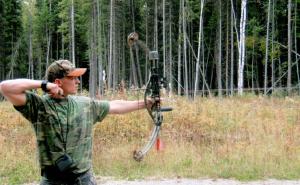The Compound Bow
The Compound Bow
Popularity of archery competitions and bow hunting have given rise to the invention of the compound bow. It is a modern technological innovation with components usually manufactured from aluminum, magnesium and various alloys. It operates on a mechanical arrangement comprising of a levering system incorporating various cams and pulleys to draw the bowstring which leads to squeezing the bow limbs inwards to store energy for shooting the arrow when the limbs spring back returning the drawstring to its original position.
There are many factors associated with the compound bow and the user must acquaint himself with them before associating with the compound bow. He must also prepare himself to a bewildering amount of technical details, specifications and jargon as he goes about selecting a compound bow suitable to his requirements.
The authour shown here shooting an arrow from his 1st compund bow, a Hoyt MT Sport.
Want a sample of related terminology? Here we go!
Energy storage/IBO speeds/Force Draw Curve/ Draw Lengths/ Draw Weights/Draw Weight Ranges/
Now to put things in a simpler and more reasonable perspective let us discuss a few of the terms. Energy storage refers to the amount of potential energy the bow can store when the strings are drawn to the maximum. This is converted into Kinetic energy once the string is released to shoot the arrow. Now energy storage is directly related to the draw weight of the bow that is the stiffness of the bow limbs. The stiffer the bow limbs, the higher the draw weight. Other factors remaining equal, a higher draw weight will result in greater arrow speed. Compound bows have specified maximum draw weights for individual models, the most common being #70. A compound bow with a #60 draw weight would shoot slower than one with a #70 draw weight, all things remaining equal.
Draw length is the distance that the bowstring can be drawn back from its position of rest on the bow. Like a traditional bow that can be drawn to virtually any length, it is not possible to draw back a compound bow more than a specified distance before it stops or hits “the back wall”. However, Some bows can be adjusted for maximum draw length while others cannot. Draw lengths for men’s compound bows can usually be adjusted from 26 inches to 30 inches, which suits men having heights from 5’5" to 6’3". An archer must determine his draw length and select a bow that is suitable. A longer draw length contributes to a longer power stroke. For rough calculations, 1 inch of draw length would be worth approx 10 fps (foot-pound per second) of arrow velocity. Compound bows are designed to shoot from the full drawn position and the draw length of each is advertised and must be checked before buying it.
IBO speed is a rating system designed by the International Bow hunting Organization (IBO) for products of compound bow manufacturers after they are tested for performance under standard test conditions. For the test the bow must be set for 70# Peak Draw Weight, precisely 30" draw length and shoot a test arrow weighing exactly 350 grains. The ratings are used for making a comparison between different makes and models of compound bows. As the industry lacks an independent testing authority most manufacturers rate their own bows and one can expect some padding up of scores. It is therefore wise not to rely solely on the IBO speed score while selecting and check other factors and read compound bow reviews also before buying.
For any serious bow hunter it is advisable to know about the players in the compound hunting bows business. Some of the leading names in the archery compound bow arena are Hoyt, PSE, Matthews Archery, Martin Compound bows, Bear Compound bows, Browning Compound bows and Bowtech Archery. All of them have a line of models each with varied specifications to suit diverse requirements of different customers. For youth compound bow shooters, 3D archery shooters, and bowhunters, you can be sure to find what your looking for in one of these companies.

